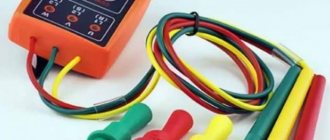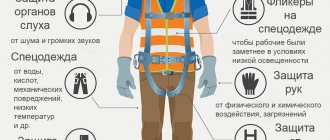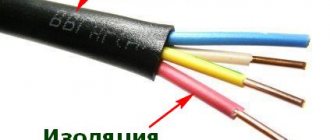In previous publications, we have repeatedly referred to protective equipment in electrical installations that provide reliable protection for electrical personnel from the destructive factors of currents. Since we have not previously delved into this issue, it’s time to talk in detail about electrical protective equipment, their specifics, classification and procedure for use. At the end of the article, we will provide some tips and recommendations that will be useful when using protective equipment in electrical installations (PPE).
Purpose and characteristics
When servicing electrical equipment connected to power, there is a danger of electric shock to electrical personnel. Moreover, the possibility of this cannot be excluded even if electrical safety standards are observed. An example is accidental contact with live structural elements when working in close proximity to them. Also, supplying voltage to the area where repair or maintenance work is being carried out can lead to tragic consequences.
Since it is not possible to completely eliminate the likelihood of such incidents, the use of personal and collective protective equipment in electrical installations is practiced. This can be dielectric clothing, insulated tools, as well as other special equipment. Their general purpose is to prevent electric shock.
The characteristics of personal protective equipment depend on the specifics of use and purpose. Let us give as an example the main parameters of latex dielectric gloves shown in the photo below.
Seamless dielectric latex gloves
List of characteristics of rubber gloves:
- The voltage class is indicated in volts, in our case up to 1000.0 V.
- Permissible leakage current is 9.0 mA (at a voltage of 10 kV).
- Strength – no less than 14 MPa.
- Operating temperature range from -40.0°C to 40.0°C.
- The minimum glove length is 350.0 mm.
- Width 130.0 - 136.0 mm.
- The minimum thickness of the rubber layer is 1.0 mm.
As you can see, the main parameters are the voltage class, operational properties and dimensions. These characteristics are also significant for other types of dielectric clothing. Naturally, measuring devices, which also belong to protective equipment (hereinafter referred to as SZ), have a significantly larger number of parameters, and these characteristics depend on both the type of product and design features.
Classification Features
The protective equipment used in electrical installations can be individual or collective. The first are designed to protect one person. These can be dielectric boots and gloves, various types of helmets, insulating stands and mats, as well as other types of PPE. The use of collective protective equipment should include the installation of protective fences, grounding, portable posters, insulating pads, etc.
In addition, depending on the voltage class, SZ is usually divided into two types:
- For installations limited to 1 kilovolt;
- Used in high-voltage systems from 1 kilovolt.
There is another significant classification criterion based on the level of reliability. Depending on it, protective equipment is divided into two groups:
- Essentially, the level of insulation of such protective equipment can provide long-lasting protection. This makes it possible to carry out maintenance of electrical installations without turning off the power.
- Auxiliary (additional). These include means that do not guarantee an adequate level of safety when working under voltage. However, they can be used in conjunction with basic special means to enhance the insulating properties of the latter.
It is typical that the same special protective equipment, depending on operating conditions, can act as primary or additional personnel protection. Such conditions are the voltage class. For example, gloves made of dielectric rubber when servicing electrical systems with voltages up to 1 kilovolt are considered the main special means of protection, but the insulation of these products is not enough when you have to work in high-voltage closed and open electrical installations, that is, those where the voltage class is >1.0 kV . Therefore, in this case, protective gloves are considered auxiliary PPE.
Having dealt with the classification, let's look at what types of protective equipment belong to each other.
Purpose
Complete with collective protective equipment, PPE is designed to ensure safe working conditions for one specific performer. That is, they can only protect the electrician who uses them.
Personal protective equipment for electrician
In practice, two main types of PPE are used, which differ in their operating principle:
- Insulating protective equipment prevents electric shock from direct contact with live parts of electrical installations. This category also includes means that provide insulation from the ground. Variants of such PPE are made using materials of the dielectric group, whose resistivity exceeds 108 Ohm*m.
- Fencing is required to prevent contact with parts of electrical equipment that may be live. Such PPE includes safety belts, claws, and barriers installed at work sites.
Every electrician must know the rules of use and the list of personal protective equipment required depending on the conditions of work. In addition, he needs to be able to check all the means at his disposal and have information about the frequency of tests that are carried out by specialized organizations.
Basic protection
We have already mentioned that the voltage class is a significant factor, so we will list special equipment separately taking into account this characteristic.
Up to 1000 V
This group includes the following types of personal protective equipment:
- Operating and measuring rods. The first ones are designed to perform various tasks, ranging from replacing safety devices to switching disconnectors or installing grounding. The latter are used to check electrical connections by measuring potential level, temperature and other characteristics at the contacts. In addition, the production of universal special rods is practiced, combining the qualities of the first and second.
Universal insulating rod - Insulating pliers, they are intended for replacing fuses, removing insulating strips and other operational operations. When testing of mites and other PPE is carried out will be described separately.
Example of using insulating pliers - Electrical measuring instruments , for example, clamps for measuring current or voltage indicators (hereinafter referred to as UN). With their help, indicators are taken from current-carrying elements.
- Gloves made of dielectric material . Despite the fact that this type of protective equipment was discussed above, it is necessary to talk about them in more detail. Gloves, like other types of dielectric clothing, can only be used when dry. Before use, it is necessary to check for mechanical damage and integrity of the product. The easiest way to do this is to roll up the glove filled with air, which will reveal a puncture if there is one.
- Specialized hand tools, on which an insulating coating is applied.
Dielectric tools set
Above 1000 V
We list the isolating devices of this group:
- All types of insulating rods and tongs . Their description was given above.
- Special designs and devices, ensuring the proper level of safety when carrying out measurements in electrical installations. These include high-voltage voltage regulators, various types of electrical clamps, special tools for tingling the insulation of cable lines, etc.
High voltage voltage indicator - Special equipment for servicing electrical systems with voltage class from 110.0 kV. An example is non-contact voltage indicators.
Non-contact voltage indicator
The article discusses the timing of periodic testing of basic and additional means of protection against electric shock, established by Order of the Ministry of Energy of the Russian Federation dated June 30, 2003 N 261, Appendix 7. As well as the standards and test time for verification of the most used dielectric PPE.
You can order testing of electrical protective equipment or purchase PPE with test reports in our electrical laboratory.
We also conduct other types of tests such as fire safety tests of materials, strength tests of materials, climatic tests of materials.
- Basic and additional PPE
- Terms and standards of periodic tests - table
- Procedure for conducting periodic inspections
Here are the test dates for the most commonly used products (see detailed information) in electrical installations:
| Image | Name | Test frequency |
| Dielectric gloves | Once every 6 months | |
| Insulating and electrical clamps | Once every 24 months | |
| Voltage indicators | Once every 12 months | |
| Plumbing and assembly tools with insulating handles | Once every 12 months | |
| Insulating rods | Once every 24 months | |
| Measuring rods | Once every 12 months |
According to the instructions for use CO 153-34.03.603-2003, protective equipment is divided into two main types.
Basic and additional means of protection
The main means of protection used in electrical installations over 1000 V include:
- insulating rods of all types;
- insulating pliers;
- high voltage voltage indicators;
- voltage indicators for checking phase coincidence,
- Electrical pliers, cable piercing devices.
- special protective equipment, insulating devices and devices for work under voltage in electrical installations with voltages of 110 kV and higher (except for rods for transfer and potential equalization).
For installations up to 1000 V:
- insulating rods of all types;
- insulating pliers;
- voltage indicators;
- electrical clamps;
- dielectric gloves;
- hand insulating tool.
The group of additional protective equipment for electrical installations (EU) over 1000 V includes:
- dielectric gloves, boots, galoshes;
- dielectric carpets and insulating supports;
- insulating caps and linings;
- rods for transferring and leveling potential;
- ladders, insulating fiberglass stepladders.
up to 1000 V:
- dielectric galoshes;
- dielectric carpets and insulating supports;
- insulating caps, coverings and linings;
- ladders, insulating fiberglass stepladders.
You can order periodic testing of protective equipment in the electrical laboratory of the “METTATRON group” or simply send a request to The email address is being protected from spambots. Javascript must be enabled in your browser to view the address.
Important. After a fall, repair, replacement of parts and signs of malfunction: protective equipment must be removed from service and undergo emergency testing, regardless of the date of the last test.
Below is a table with the indicated deadlines and standards for electrical testing of protective equipment.
| Name of the protective equipment | Electrical installation voltage, kV | Test voltage, kV | Test duration, min. | Current flowing through the product, mA, no more | Test frequency |
| Insulating rods (except for measuring ones) | Up to 1 | 2 | 5 | — | 1 time per 24 months |
| Up to 35 | 3x linear but less than 40 | 5 | — | ||
| Insulating rods (except for measuring ones) | 110 and above | 3x phase | 5 | — | 24 months |
| Insulating part of portable grounding rods with metal links | 6 — 10 | 40 | 5 | — | 24 months |
| 110 — 220 | 50 | 5 | — | ||
| 330 — 500 | 100 | 5 | — | ||
| 750 | 150 | 5 | — | ||
| 1150 | 200 | 5 | — | ||
| Insulating flexible grounding elements of rodless design | 500 | 100 | 5 | — | 24 months |
| 750 | 150 | 5 | — | ||
| 1150 | 200 | 5 | — | ||
| Measuring rods | Up to 35 | 3x linear but less than 40 | 5 | — | Once every 12 months. |
| 110 and above | 3x phase | 5 | — | ||
| Measuring rod heads | 35 — 500 | 30 | 5 | — | 24 months |
| Longitudinal and transverse strips of slider heads and insulating nylon rope of measuring rods | 220 — 500 | 2.5 by 1 cm length | 5 | — | 24 months |
| Insulating pliers | Up to 1 | 2 | 5 | — | 1 time per 24 months |
| Above 1 to 10 | 40 | 5 | — | ||
| Up to 35 | 105 | 5 | — | ||
| Voltage indicators above 1000 V: | Once every 12 months. | ||||
| - insulating part | To 10 | 40 | 5 | — | |
| Above 10 to 20 | 60 | 5 | — | ||
| Above 20 to 35 | 105 | 5 | — | ||
| 110 | 190 | 5 | — | ||
| Above 100 to 220 | 380 | 5 | — | ||
| — working part <> | To 10 | 12 | 1 | — | |
| Above 10 to 20 | 24 | 1 | — | ||
| 35 | 42 | 1 | — | ||
| — indication voltage | No more than 25% of the rated voltage of the electrical installation | — | — | ||
| Voltage indicators up to 1000 V: | Once every 12 months. | ||||
| — housing insulation | Up to 0.5 | 1 | 1 | — | |
| Above 0.5 to 1 | 2 | 1 | — | ||
| - high voltage test: | |||||
| single pole | Up to 1 | 1.1 Uwork max. | 1 | — | |
| bipolar | Up to 1 | 1.1 Uwork max. | 1 | — | |
| — checking the current through the pointer: | |||||
| single pole | Up to 1 | Uwork max. | — | 0,6 | |
| bipolar <> | Up to 1 | Uwork max. | — | 10 | |
| — indication voltage | Up to 1 | Not higher than 0.05 | — | — | |
| Voltage indicators for checking phase coincidence: | Once every 12 months. | ||||
| - insulating part | To 10 | 40 | 5 | — | |
| Above 10 to 20 | 60 | 5 | — | ||
| 35 | 105 | 5 | — | ||
| 110 | 190 | 5 | — | ||
| - working part | To 10 | 12 | 1 | — | |
| 15 | 17 | 1 | — | ||
| 20 | 24 | 1 | — | ||
| 35 | 50 | 1 | — | ||
| 110 | 100 | 1 | — | ||
| — indication voltage: | |||||
| according to the consonant connection scheme | 6 | Not less than 7.6 | — | — | |
| 10 | Not less than 12.7 | — | — | ||
| 15 | At least 20 | — | — | ||
| 20 | At least 28 | — | — | ||
| 35 | At least 40 | — | — | ||
| 110 | At least 100 | — | — | ||
| according to the counter-connection scheme | 6 | Not higher than 1.5 | — | — | |
| 10 | Not higher than 2.5 | — | — | ||
| 15 | Not higher than 3.5 | — | — | ||
| 20 | Not higher than 5 | — | — | ||
| 35 | No higher than 17 | — | — | ||
| 110 | Not higher than 50 | — | — | ||
| - connecting wire | Up to 20 | 20 | — | — | |
| 35 — 110 | 50 | — | — | ||
| Clamp meter | Up to 1 | 2 | 5 | — | 1 time per 24 months |
| Above 1 to 10 | 40 | 5 | — | ||
| Cable piercing devices: | Once every 12 months. | ||||
| - insulating part | To 10 | 40 | 5 | — | |
| Dielectric gloves | All voltages | 6 | 1 | 6 | Once every 6 months |
| Dielectric boots | All voltages | 15 | 1 | 7,5 | Once every 36 months. |
| Dielectric galoshes | Up to 1 | 3,5 | 1 | 2 | Once every 12 months. |
| Insulating pads: | Once every 24 months | ||||
| - hard | Up to 0.5 | 1 | 5 | — | |
| Above 0.5 to 1 | 2 | 5 | — | ||
| Above 1 to 10 | 20 | 5 | — | ||
| 15 | 30 | 5 | — | ||
| 20 | 40 | 5 | — | ||
| — flexible from polymeric materials | Up to 0.5 | 1 | 1 | 6 | |
| Above 0.5 to 1 | 2 | 1 | 6 | ||
| Insulating caps for the cores of disconnected cables | To 10 | 20 | 1 | — | Once every 12 months. |
| Single layer insulated insulating tool | Up to 1 | 2 | 1 | — | Once every 12 months. |
| Special protective equipment, insulating devices and devices for work under voltage in electrical installations with voltages of 1100 kV and above | 110 — 1150 | 2.5 by 1 cm length | 1 | 0,5 | Once every 12 months. |
| Flexible insulating coatings for live work in electrical installations up to 1000 V | Up to 1 | 6 | 1 | 1 mA/1 sq. dm | Once every 12 months. |
| Flexible insulating strips for live work in electrical installations up to 1000 V | Up to 1 | 6 | 1 | — | Once every 12 months. |
| Insulating ladders and stepladders | Up to and above 1 | 1 per 1 cm of length | 1 | — | Once every 6 months |
<*> Testing of the working part of voltage indicators up to 35 kV is carried out for indicators of this design, during operations with which the working part can cause a phase-to-phase fault or a phase-to-ground fault.
<**> For two-pole voltage indicators with an incandescent lamp up to 10 W with a voltage of 220 V, the current value is determined by the power of the lamp.
Procedure for conducting electrical performance tests.
Let us highlight only the key points in conducting tests.
For more information about periodic checks of dielectric gloves and voltage indicators, read our articles.
Before testing, all products must undergo an external inspection in order to check the presence of manufacturer's markings, numbers, completeness, absence of mechanical damage, and the condition of insulating surfaces (for insulating protective equipment). If the protective equipment does not comply with the requirements of instructions SO 153-34.03.603-2003, tests are not carried out until the identified deficiencies are eliminated.
The time for applying the full test voltage is 1 minute for protective equipment up to 1000 V, insulation made of elastic materials and porcelain. For products with insulation made of layered dielectrics - 5 minutes.
Breakdown, flashover, and surface discharges are determined by turning off the testing facility during testing, by readings from measuring instruments, and visually.
Electrical protective equipment made of solid materials should be checked by touch immediately after testing for the absence of local heating due to dielectric losses.
In the event of breakdown, overlap, increase in current through the product above the normalized value, or the presence of local heating, the protective equipment is rejected. On protective equipment that did not pass the test, the stamp must be crossed out with red paint.
The following stamps are applied to products that have passed the tests:
Electrical laboratory stamp confirming successful testing of personal protective equipment, the use of which depends on the voltage of the electrical installation
Test stamp for protective equipment, the use of which does not depend on the electrical voltage (dielectric gloves, galoshes, boots, etc.)
The laboratory specialists who carried out the tests must enter information into the PPE inspection and testing log,
Sample PPE inspection log
Draw up and issue a test report drawn up in accordance with the requirements of GOST R 51000.3-96.
Test report form for PPE against electric shock
- Dielectric gloves - inspection and test timing
- Why do we test products for electrical strength?
- Phasing of power cables and distribution units (RU)
Additional electrical protective equipment
Let's move on to consider auxiliary protective equipment in electrical installations, which, like the main ones, are usually divided by voltage class. Please note that with the main means of protection in electrical installations up to 1000V, it is allowed to use only one additional means of protection, if this does not contradict production factors or technical requirements.
Up to 1000 V
Isolating devices of this group include:
- Safety shoes in the form of dielectric galoshes or rubber boots. With the help of such products it is possible to avoid exposure to electric currents connected to the ground. It is recommended to use if the floor in the work area has a conductive coating.
Dielectric bots - Insulating stands and dielectric carpets . The purpose of this PPE is the same as that of safety shoes. The use of carpets and stands is allowed in closed spaces (except for damp rooms) and in open spaces (in dry weather).
- A variety of insulating linings and caps . They physically prevent accidental switching on of the line on which technical work is being carried out.
Above 1000 V
High voltage auxiliaries include:
- Safety shoes and gloves with appropriate dielectric characteristics.
- Safety helmets, specialized suits, etc.
- Portable grounding and fencing of live parts.
It is typical that when working in high-voltage installations with basic protective equipment, several types of auxiliary personal protective equipment are used.
Sad statistics
According to statistics, up to 30,000 people die from electric shock every year. Most often, the causes of electrical injuries are ignorance of the mechanism of physiological effects of electric current on the human body, violation of current rules and instructions on occupational safety and non-use of personal protective equipment.
The consequences of possible injury from direct electric current can be different - from quite mild to very sad, for example:
- convulsive muscle contraction without loss of consciousness;
- convulsive muscle contraction with loss of consciousness, but with preserved breathing and heart function;
- loss of consciousness and disturbances in cardiac activity or breathing (or both);
- clinical death, that is, lack of breathing and blood circulation.
The following components influence the outcome of an electric shock:
- the duration of passage of electric current through the human body;
- frequency and type of current;
- physiological characteristics of a person;
- resistance to stress;
- voltage value.
Every employer must make every effort to eliminate the causes of electrical injuries at the enterprise. First of all, this is facilitated by the training of personnel servicing electrical installations and the use of the necessary PPE. By the way, the employer must provide personal protective equipment to employees completely free of charge when working in electrical installations.
Test frequency
According to the requirements of the standards, all protective equipment in electrical installations are subject to regular verification; we are talking about high-voltage insulation tests. Below is a table indicating the testing frequency for various PPE.
Table 1. Regularity of operational tests.
| product name | Testing frequency (in months) |
| Various types of insulating rods | 24 |
| Measuring rods | 12 |
| Insulation and current clamps | 24 |
| UN, including high voltage | 12 |
| Electrical insulating gloves | 6 |
| Safety shoes (boots) | 36 |
| Safety shoes (galoshes) | 12 |
| Checking the insulation of instruments | 12 |
Check before use
Before each use, the electrician must make sure that the period of the next PPE test has not passed; this information is indicated on special stamps. In addition, an external inspection is mandatory, and if damage to the insulating coatings is detected, the products must be sent for extraordinary testing. Dielectric gloves are additionally checked for leaks by filling them with air and twisting them. If leaks are detected, use is unacceptable.
We pay attention to the correct selection of personal protective equipment depending on the conditions of use, compliance with the frequency and procedure for carrying out inspections or tests. Violations in these matters will cause electrical injuries, including death.
Procedure for using protective equipment
According to the current Rules, PPE, as inventory property, must be stored in premises designated for this purpose and issued to field teams or for individual use.
Only those protective equipment in electrical installations that have passed tests are allowed for use, and there is a corresponding entry on the product stamp.
As for the norms of distribution, they depend on internal regulations, which take into account the characteristic conditions in a particular organization. But at the same time, violations of the requirements of safety and labor protection standards are not allowed. When distributing, information about storage locations is required to be retained. For this purpose, special lists are provided, recorded with the signature of the responsible person and the seal of the organization.
If during the testing process or during an external inspection unsuitable personal protective equipment is identified, they are subject to write-off, followed by removal from the storage location. Information about this should be reflected in the protective equipment record book or operational documents, for example, when the unsuitability of personal protective equipment is discovered on the road.
Electrical personnel, after receiving PPE in hand, bears full responsibility for compliance with operating rules and must be able to independently determine their current condition, as far as possible under working conditions. In this case we are talking about external inspection for integrity.
The use of a special tool must be carried out in accordance with its purpose and in accordance with the tolerance established for the parameters of the DC or AC electrical network.
Protective equipment in electrical installations intended for enclosed spaces can be used in open spaces, but only if the weather is dry. In case of frost, rain or high humidity, it is necessary to use specialized tools designed for use in such weather conditions. A note on the relevant electrical tests must be included in the product passport.
Before starting to operate PPE, electrical personnel are required to check for any punctures in the insulation or other damage. It is mandatory to check the permissible service life and the date of the last tests. This information is contained in the stamp. It is strictly prohibited to use expired protective equipment during work!
To avoid exposure to touch voltage, do not touch the working surfaces of PPE during operation, as well as insulating parts outside the limiting stop or ring.
Classification
Current regulations also provide for the classification of PPE according to purpose and permissible conditions of use. It is customary to subdivide into:
- Basic electrical protection necessary for carrying out work in the presence of voltage on live parts of equipment or networks. The main requirement for such products is that they must have insulating characteristics that will allow them to withstand the voltage present for a long time.
Basic PPE - Additional electrical protection, which by themselves cannot protect a person from prolonged contact with live parts of equipment or mechanisms. They are used only in conjunction with basic personal protective equipment and are able to prevent injury when exposed to step voltage or accidental contact with conductive elements (touch voltage).
Additional PPE
Each of the listed types, in turn, is divided into categories according to the permissible voltage at which their use is possible. There are two groups:
- PPE that allows you to perform electrical installation work or repairs, equipment maintenance at a voltage not exceeding 1 kV.
- Personal protective equipment for working on high-voltage installations or networks at voltages over 1 kV.
The main differences between the products of these groups are the quality of the dielectrics used. Note that the main tools and devices intended for up to 1 kV can be used as additional ones if the indicator exceeds this limit.
Basic PPE
The most common types used for working with equipment or electrical networks at voltages up to 1 kV include:
- Operating rods necessary for performing operations related to the maintenance or control of electrical installations. With their help, switching operations with disconnectors and grounding connections are carried out. They are a handle made of a material with dielectric properties on which an actuator or gripper is installed.
Operating rods - Measuring rods have a similar design, but instead of grippers they are equipped with equipment for measuring resistance, voltage, temperature, current, and other characteristics. Universal rods that combine the capabilities of operational and measuring devices have also found application.
High voltage measuring rod - Insulating pliers are designed to replace fuse links, busbar fuses and to perform other maintenance operations on live electrical equipment. The difference with operating rods is that they are a pliers tool with two long, insulated handles that allow you to perform work at a distance from parts of the equipment.
Insulating pliers - Electrical measuring instruments designed to take readings directly from conductive elements or contacts of electrical equipment. Clamps for determining current strength, megohm meters for monitoring insulation resistance, voltage indicators (VT) and other devices for monitoring the parameters of electrical circuits.
Electrical measuring instrument - Dielectric gloves also belong to the main types of personal protective equipment for work at voltages not exceeding 1000 V. Like other insulating clothing, they are used exclusively in a dry state, even the minimal presence of moisture on the surface can cause electric shock to the performer (the table with the date of the last check is shown in black , inspection organization, etc.).
Dielectric gloves - Part of the PPE consists of insulated hand tools, which every electrician who performs maintenance, repairs, connecting electrical equipment and when working with electrical networks should have. This list includes screwdrivers, pliers and pliers, pliers and side cutters. Open-end or socket wrenches, knives or strippers, and other devices are also used. It is recommended to use hand tools with VDE marking that comply with European electrical safety requirements. It is distinguished by multi-layer coating of hazardous areas with insulating materials. Moreover, the main protection is the top layer of polyformaldehyde, which has high dielectric characteristics.
Isolated hand tool
Please note that when working at high-voltage installations, these basic personal protective equipment cannot ensure complete safety of work. If the value exceeds 1000 V, it is necessary to use specialized personal protective equipment:
- Rods and clamps whose insulating characteristics provide long-lasting protection against high voltage.
- Special devices and structures that should ensure the safety of measurement work. These include tools for piercing insulation, high-voltage electrical clamps and UN.
- To work on installations and networks with a voltage class of more than 110 kV, non-contact measuring devices are used, for example, voltage indicators.
Please note that only electricians with the appropriate permit can be involved in carrying out work in such conditions.
Additional protections
This category of PPE is also divided according to the permissible voltage at the work site. The difference lies in the dielectric characteristics, so we will give only a general list, but you should check the conditions under which they are intended:
- Protective dielectric footwear (boots, galoshes), which allow you to avoid the passage of currents through the body that are shorted to the ground. Such products are recommended for use in premises and kiosks in cases where the floor is made of conductive materials.
Dielectric safety shoes - Dielectric mats and insulating stands have a similar purpose. Can be used both indoors and outdoors, but only in dry weather.
- Insulating caps or covers to prevent equipment from turning on and causing electrical power to enter the work area.
Insulating hoods - Specialized suits, safety glasses, helmets to avoid injury in the event of discharges and other emergency situations.
- Portable structures and devices for fencing and grounding of conductive parts of serviced equipment.
Portable ground electrodes
It is recommended to use a combination of primary and several auxiliary PPE.









